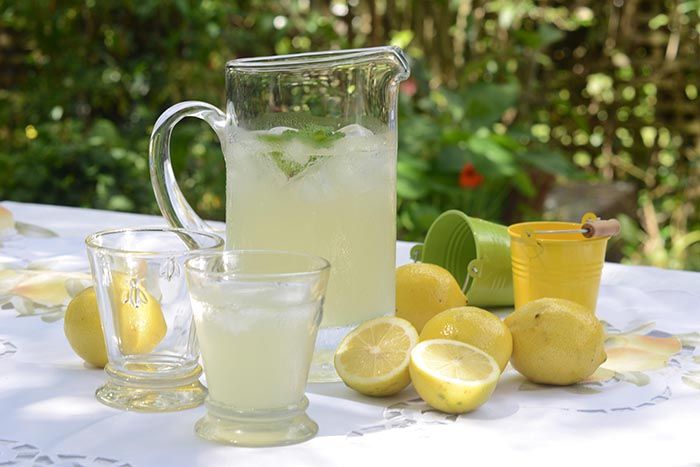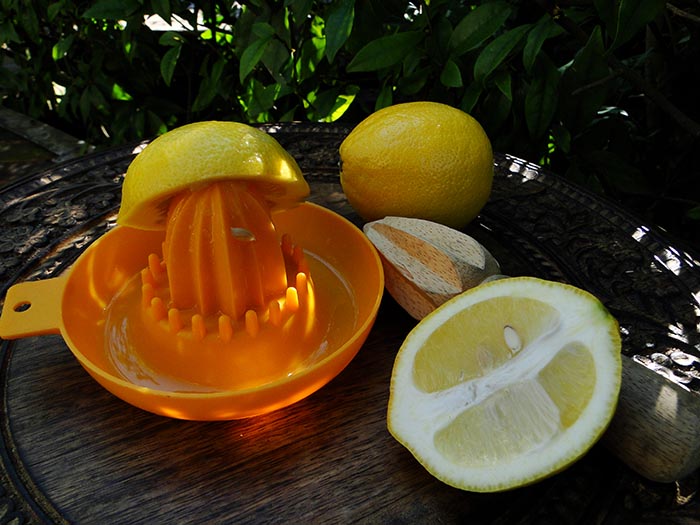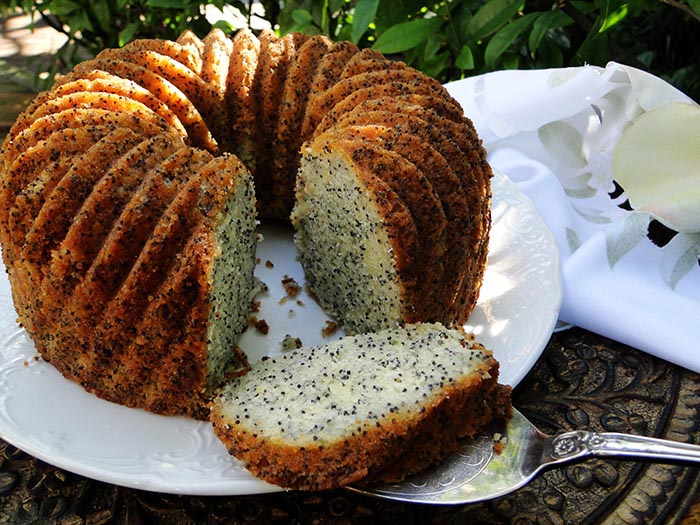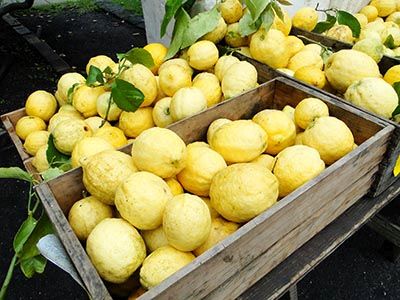Meditation on Lemons
Meditation on Lemons
When I move house
the first tree I plant
is a lemon
biblical
dour and versatile
I much prefer it
to those cloying salesgirls
the soft stone fruits
– Kate Llewellyn, excerpt from “Lemon”
It’s a hot summer afternoon in the Tallebudgera Valley in the hinterland of Queensland’s Gold Coast.
My sister is sitting at a wooden table under the shade of a mango tree on the family farm, squeezing lemons. It’s not easy for her because her wrists are weak and giving her grief, but she perseveres all the same.
She’s invited some children from the local school on a tour of the orchard and is making a batch of lemonade as refreshment, using the recipe from my Mini Chef: Cooking with Kids book.
It’s simple and straightforward and she’s already made the sugar syrup base. Now she just needs to add the strained lemon juice and put it in the fridge to chill.
She’s quadrupled the measurements, but if you’d like to make it, you’ll need to combine 1 cup caster in a saucepan with ½ cup water and the finely grated zest of 1 lemon, bring it to the boil and leave it to simmer gently until the sugar has dissolved and you have a light syrup. Remove the pan from the heat and when cool, add the juice of three lemons. Strain the syrup into a small jug and place it in the fridge until chilled. When ready to serve, pour about a centimetre of the syrup into a glass, add ice and top with sparkling or still water.
There are many ways to squeeze the juice. During summer, I suggest using lemons at room temperature. If the weather is cool – or if you’ve just taken them from the fridge – place them in a bowl of warm water for a minute or two or microwave them for 10 – 20 seconds until the skin feels warm. This helps to loosen the membranes and to release the juice. Now take the lemon and roll it firmly back and forth on the benchtop for a few seconds, then cut it with a sharp knife lengthwise, not crosswise, because the larger amount of surface area exposes more of the pulp.
Place one of the halves onto a juicer with the cut side facing down, press down firmly on the lemon half and rotate it and hallelujah, you’ll be delighted by the amount of juice which is released.
I’ve always thought that every back garden should have a lemon tree, even if it’s a bush lemon. In winter, when most trees are dormant, the sight of these vivid yellow fruits dancing on a tree is a delight.
In his evocative poem, I Limoni, the Italian poet Eugenio Montale captured the lure of these “golden trumpets of sunshine” in the midst of winter:
Rain then
wears the earth out, dreary winter
settles down around the houses,
light grows miserly, the soul bitter,
till one day, through a half-
shut gate, you see
among the trees in someone’s yard
the yellows of lemons –
and the heart’s ice melts,
and with their music
the golden trumpets of sunshine
blow your bones wide open.
And pray tell me, where would the cook be without the lemon to add zest to our food and bring a little sunshine to the table? Its acidity acts as a flavour enhancer in so many dishes.
As Margaret Visser informs us in “Much Depends on Dinner”, a modern kitchen without a lemon is gravely ill-equipped. And, I would quickly add that a modern kitchen without a zester or microplane to remove the zest is even more gravely ill-equipped.
When you cut a lemon – or grate its zest – its lively fragrance is unmistakeable; when you add its juice to your cooking its sourness arouses your taste buds and stimulates your appetite.
Perhaps we take lemons too much for granted? They grow so abundantly in the backyards of sub-tropical Australia that it can sometimes be difficult to know what to do with the excess fruit.
But not for German poet Rainer Maria Rilke. Coming from a cold northern climate, he was captivated by their beauty, smell and taste, as well as their promise of the warm south. “How I live it, this fragrance of lemons,” he wrote. “God knows how much I owe to it at times.” In a letter to his wife dated 1901, he imagines a simple country tea which includes these evocative fruits:
“There would be some tea ready to be drunk, yellowish golden tea in glasses with silver sauces, giving off a faint fragrance…Huge lemons, cut into slices, would sink like setting suns into the dusky sea, softly illuminating it with their radiating membranes, and its clear, smooth surface aquiver from the rising bitter essence.”
Yet he neglects to mention the intoxicating perfume of a lemon tree in flower – and of the leaves when crushed in your hand. Perhaps he had never seen – or smelt – a lemon tree in blossom.
No matter, because the Chilean poet, Pablo Neruda, certainly had.
Out of lemon flowers
loosed
on the moonlight, love’s
lashed and insatiable
essences,
sodden with fragrance,
the lemon tree’s yellow
emerges
Over the past 40 years, my mother has planted numerous varieties of citrus trees on the hill sloping down towards the river, the most abundant of which are the Eurekas. She’s also planted Lisbon and Meyer varieties but curiously not the Lemonade variety which originated in Australia during the 1980s and, I’ve been told, is a lot sweeter and can be eaten straight from the tree, just like a mandarin or orange.
A few self-seeding bush lemons (Citrus jambhiri) have also sprung up in the orchard at the farm, the fruit of which have strongly flavoured rind though they vary in the amount of juice they contain. I suspect they’ve followed my sister here because wherever she decides to put down roots, she finds a drooping old bush lemon.
Because of the intense flavour of their rind, bush lemons are good for preserving Moroccan-style, though you can use other varieties as well.
My sister gives them a good scrub and cuts them into quarters lengthwise stopping 1cm from the bottom so that the lemon fans out but remains attached at one end. She then sprinkles the flesh of each lemon with 1 tablespoon of sea salt, closes it up and packs it into a large sterilised jar, pushing the lemons down with the handle of a clean wooden spoon to release as much juice as possible and maximise the number of lemons in the jar. Once the jar is full, she tops the lemons with extra lemon juice until they are completely covered, then seals the jars tightly and leaves them in a cool dark place for 4 weeks, occasionally turning the jar upside down.
When she wants to use them in a tagine, or to add a lemony kick to a chicken stew, couscous, olives or a salad, she cuts away the flesh, rinses off the salt from the rind under cold water, then dices or slices it finely. Because of their potent flavour, you only to need a small amount, as in this colourful Moroccan Fish Tagine. Make sure to set aside a couple of hours to marinate the fish in the chermoula.

Moroccan Fish Tagine
The origin of the lemon (Citrus limon) is something of a mystery. It is thought to have originated in the eastern Himalayan regions of India or perhaps southern China, possibly as a hybrid of the citron and lime, and its name to be derived from the Hindu word lemoen.
The Greeks acquired it through their trade with Iran where it had been cultivalted some time between 2500 and 500BCE and used it to flavour their soup and fish sauce
By the fourth century AD the fruit and its trees were depicted in Roman mural paintings, the agricultural writer Palladius having planted the first lemon tree in Italy in that century. Interestingly, there is no Latin word for lemon which suggests it was grown more as an ornamental than for its fruit.
It wasn’t until the eighth century that its fortunes were revived by the Arabs who planted lemons in the Sahara desert and established the lemon orchards of Andalusia in Spain and from there to Spain and Italy. The Sicilians salted their lemons and ate them with cayenne pepper, not unlike the Moroccan preserved lemons we know today. They also use lemons in salads as in Jamie Oliver’s Sicilian Lemon Salad
in which he cuts all the skin and bitter pith from the lemons, slices them thinly and tosses them with olive oil, sea salt and cracked pepper to accompany a mixed grill.
Beware of that pith because that is where the bitterness lies, the part of the lemon which makes your mouth pucker, and the reason why lemons are seldom eaten whole.
But combined with other ingredients, such as sugar, eggs and cream, and used judiciously, they make heavenly treats such as this Lemon Tart, a recipe adapted from one given to me many years ago by Greg Doyle of Pier Restaurant, Rose Bay. It’s become one of the great classics.
Lemon Tart
If you blanch the citrus zest in boiling water for a minute, then refresh under cold water, it removes any bitterness. Dry on paper towels, then add to the mixture.
Sweet shortcrust pastry:
250g (2 cups) plain white flour
110g (2/3 cup) icing sugar
125g unsalted butter, roughly chopped
1 large egg
1 egg white, whisked until fluffy
Lemon Filling:
4 eggs
75g (1/3 cup) caster sugar
150ml thickened cream
150ml lemon juice, freshly squeezed and strained
Zest of 1 lemon, finely grated
For the pastry: Place the flour and icing sugar in the bowl of a food processor and process to combine. Add the butter and process until mixture forms breadcrumbs. Add the egg and process until dough wraps around the blades. Remove from the bowl and knead on a lightly floured bench to combine thoroughly. Wrap in greaseproof paper and chill for a couple of hours.
Roll out on a lightly floured bench and line a 25 – 26cm loose-bottomed flan tin. Press the dough in firmly and trim any excess. Return to rest in the refrigerator for an hour.
Preheat oven to 200degC. Remove pastry and brush all over with beaten egg white, return to fridge for ½ hour, then bake until lightly coloured all over.
Turn down oven to 150degC. Pour filling into prepared flan case using a jug. The best way to do this is to place the pastry case on a rack in the oven, then fill it as high as possible without having to move it. Bake 30 – 35 minutes. It may look a little wobbly but will set as it cools.
For the filling: Whisk together the eggs and sugar until pale and thick. Mix in the cream then add the juice and zest at the last moment.
Why not plant a lemon tree today?





